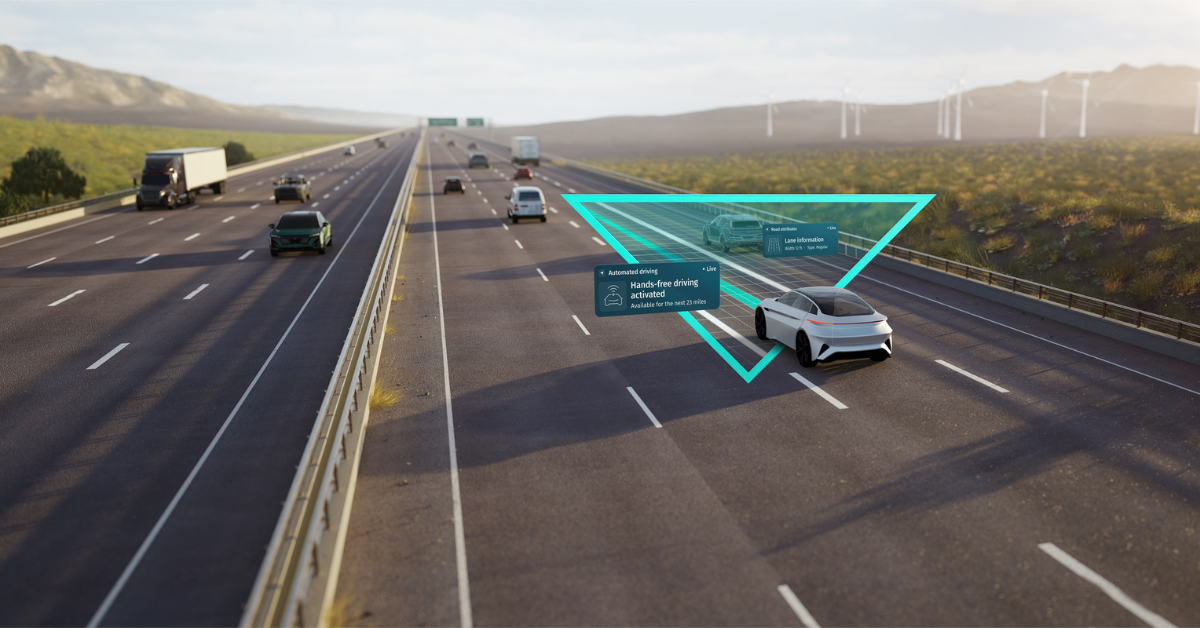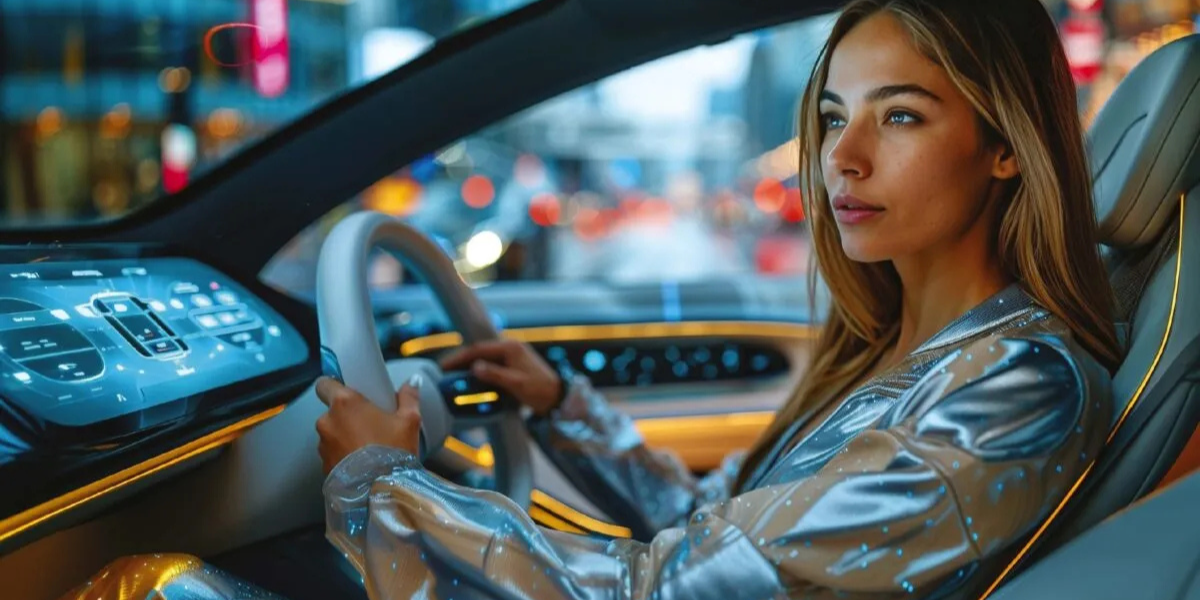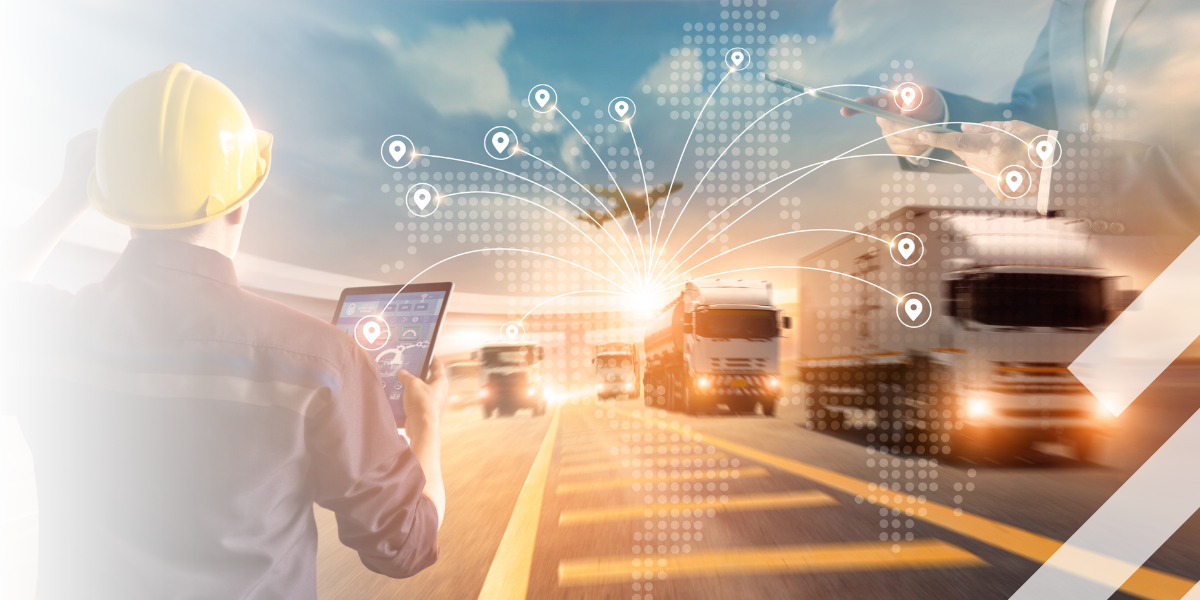While flying cars may sound as if they belong to science fiction, technology seems to have brought them closer to reality—potentially helping to create a faster, cheaper, cleaner, safer, and more integrated transportation system.
A century ago, aviation pioneer Glenn Curtiss debuted the Autoplane, a three-seat car-cum-aircraft with removable wings. Ever since, automobile and aviation enthusiasts have been dreaming of “flying cars.” Flying can replace driving in cities around the globe, saving people's time as trips that take hours on the ground can be reduced to minutes in the air, improving productivity and quality of life. After decades of failed projects and false starts, we may now be on the threshold of this vision becoming a practical reality.
This new class of vehicles is emerging in the midst of an already dramatic transformation in the way people and goods move around. Driven by a series of technological and social trends, from ridesharing and bikesharing to electric and autonomous vehicles and beyond, the future of mobility could ultimately create a more integrated transportation system that is faster, cheaper, cleaner, and safer than today’s. Even as players across a host of industries come to grips with these changes to terrestrial mobility, advances in flying cars could add, literally, an entirely new dimension to an already complex landscape.
While we are early in this journey, market segments seem to be forming, some early entrants are experimenting, regulations are being formulated, and technology is developing. This study looks at the emerging market for personal mobility, exploring both the current state of the technology—including the rapid advances made in recent years—as well as the many hurdles that remain before flying cars become widely adopted. It also examines important questions related to the regulatory framework and supporting infrastructure. Finally, the study explores how widespread use of passenger drones could reshape urban mobility, and suggests some key steps players in aerospace and other industries can do now to prepare for this exciting possibility, as well as what disruptions to possibly expect.
Passenger drones and flying cars are nearing commercial availability
The technology and product development of passenger drones and traditional flying cars seem to be swiftly progressing. These vehicle concepts have been under development since the 1980s, and various prototypes already exist, with the majority capable of vertical takeoff and landing (VTOL). A VTOL vehicle is an aircraft that takes off, hovers, and lands vertically and does not require runways. For this study, our definition of VTOL excludes any type of helicopter. While traditional helicopters have had this capability since their inception, most are considered highly energy inefficient, seeming to prevent large-scale operations. Many companies today are instead focusing on electric or hybrid-electric designs with VTOL capabilities. These vehicles, popularly called flying cars or passenger drones, are designed to accommodate around two to five passengers or the equivalent cargo weight; be highly energy efficient, with reduced or zero emissions; and be substantially quieter than a traditional helicopter.
Several categories exist under the broad group of these proposed urban mobility vehicles, each with distinct characteristics and potential uses:
- Passenger drones: A passenger drone is expected to be an electric or hybrid-electric quadcopter (although some may have more than four rotors) that can be used to move people or cargo between both established and on-demand origination and destination points. These vehicles can be either manually piloted, remotely piloted, or fully autonomous. When piloted, the pilots require a license or certification. Passenger drones would cover short to medium-range distances (up to 65 miles).
- Traditional flying cars: A traditional flying car would be a vehicle where the driver/pilot can drive the vehicle in its car configuration to an airport, reconfigure the vehicle to an airplane mode, and then fly to a destination airport. It is designed to carry people and fly medium to long distances (50 to 200 miles). Currently, it would need to be operated by a licensed pilot, but it could be made fully autonomous and pilotless/driverless over time. In the near future, flying cars are likely to become VTOL capable.
- Revolutionary vehicles: Revolutionary vehicles, which are expected to be a combination of passenger drone and traditional flying car, would be fully autonomous vehicles that can start or stop anywhere, with speed and range (distances greater than 200 miles) beyond passenger drones and the traditional flying cars. These vehicles have advanced VTOL capability and therefore can land and take off from almost anywhere because they may not require an established airport/vertiport. These would likely be piloted by a licensed pilot initially, but they could be made fully autonomous over time..
Figure 1. Lists and compares some of the major flying car and passenger drone manufacturers and their proposed vehicles.

With the increasing popularity of small unmanned aerial vehicles or drones, and regulations increasingly supporting their commercial use, passenger drones and flying cars appear to be moving closer to reality, with aerospace and aircraft design technology being developed rapidly. Many passenger drone and flying car manufacturers have already passed the conceptualization/design phase, and a majority of them are currently in the prototyping and testing stage, with most manufacturers expecting delivery by 2020 (figure 2).
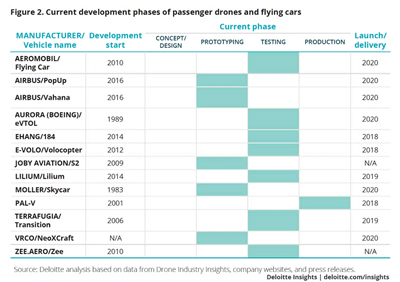
In terms of technology, the industry is at an advanced development phase, and if safety and regulatory hurdles are cleared, passenger drones are expected to get wings by 2018–2020, and traditional flying cars by 2020–2022, while revolutionary vehicles could be a reality only by 2025
There are numerous potential applications for these new forms of urban mobility vehicles (table 1). For many of these, the airborne trip could be just one leg of a multimodal journey and potentially accessed via a single, integrated mobility-as-a-service interface.7 For example, a traveler could be picked up by a ride-hailing car from her home in the suburbs, driven to a nearby “vertiport,” and flown to another vertiport at the city’s edge, before taking the subway to her destination.
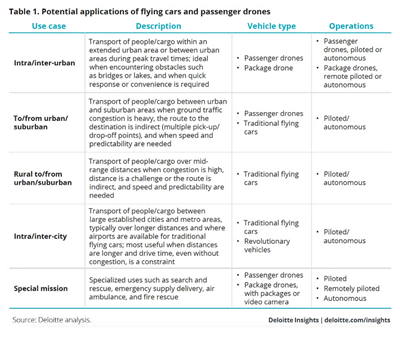
Challenges to taking flight
Despite the technological progress and many potential applications for these aircraft, there are various challenges to consider with respect to regulations, certifications, infrastructure, and air traffic management (figure 3). While possibly daunting, none of these challenges are insurmountable, and the aerospace and related industries have navigated similarly complex challenges before—not least of which is the development and deployment of commercial airplanes. The key could be close collaboration between regulators and private sector stakeholders across the extended mobility ecosystem.
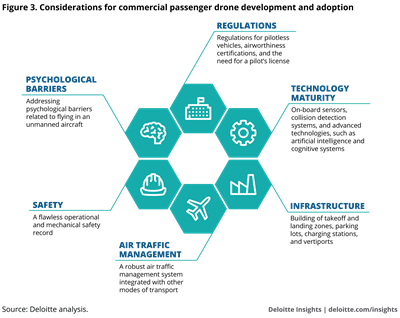
Regulations
From a regulation perspective, the Federal Aviation Administration (FAA), its equivalent agencies around the world, and other transportation-related regulatory agencies have to weigh in on the requirements for these piloted and autonomous passenger drones: Is a pilot’s license required? What airspace can they occupy? What are the vehicle airworthiness requirements? There is some progress as the FAA has already started discussing certification options with some manufacturers and believes that initially these vehicles should be manned, then autonomously assisted, and then converted to a fully autonomous aircraft at a later stage. While regulations related to piloted passenger drones and flying cars could be relatively easy to address, fully autonomous VTOL operations are likely to be more challenging, with issues around how to allocate the use of the airspace (lower altitudes to higher altitudes) considering the exponential growth in piloted and autonomous vehicles utilizing the airspace. Beyond the FAA, the US Department of Transportation and other agencies will likely have to consider autonomous cars; for now, regulatory agencies would need to focus on issuing nonbinding guidelines while avoiding binding regulation as the technology is still in flux.
Currently, national and local regulatory authorities are addressing regulations related to smaller drones. For example, in the United States, the FAA is considering extending commercial operations of drones over controlled airspace beyond visual line of sight.These advancements could be a starting point for regulations related to passenger drones and flying cars, and, ultimately, for revolutionary vehicles.
Technology maturity
In terms of technology, there are various considerations for VTOL manufacturers. First, in a GPS-denied environment, these vehicles would need on-board sensors such as radar, optics, and geolocation sensors. While these technologies exist and are being utilized in autonomous cars, they would have to be improved to provide the longer-range sensing and recognition capabilities required to deal with the multidirectional and convergence speeds associated with autonomous flight. Second, these vehicles would require advanced technologies, such as artificial intelligence and cognitive systems, to enable advanced detect-and-avoid capabilities. Machine learning could be essential as operations move from piloted to autonomous: A vehicle would need to learn from the pilot’s actions over thousands of operational hours to become fully autonomous over time. Third, energy management is crucial: carrying an energy load sufficient to transport passengers or cargo, maintain a safety margin, and reload for the next flight. While battery technology is rapidly improving, in order to increase passenger and cargo capacity and extend the ranges of passenger drones, it will need to improve further, or alternatives would need to be found.
Infrastructure
Infrastructure constraints include proper takeoff and landing zones, and parking and battery charging stations. A wide network of vertiports would require either new infrastructure or existing infrastructure, such as helipads, rooftops of large public buildings, and unused land, to be modified. To create a truly unified traffic management system, additional infrastructure may need to be installed along predefined flight corridors to aid high-speed data communications and geolocation. All these infrastructure changes would require the collaboration of commercial stakeholders and the local urban planning authorities.
Air traffic management
There would have to be a robust air traffic management system in place to guarantee safe and efficient operations of passenger drones and flying cars, which would meet the requirements of the FAA and the European Aviation Safety Agency. To achieve this, industry leaders and manufacturers would likely need to reach an agreement on a reliable traffic management framework that integrates with other modes of transport, especially in urban areas. In the United States, there is already progress, with Uber and NASA recently signing a Space Act Agreement for traffic management of autonomous vehicles that will fly at a low altitude.
Safety
For the scaled adoption of passenger drones and flying cars (particularly fully autonomous) to occur, the operators of these vehicles would likely need to demonstrate a near-flawless safety record, covering both mechanical integrity as well as safe operations. As we have seen with autonomous cars, any mishap can garner significant attention and can slow the pace of adoption. While achieving mechanical integrity would be easier, the operations of VTOL in suburban and urban areas could pose unique challenges—some of which are described in the aforementioned infrastructure section.
Psychological barriers
Apart from other considerations, people also need to overcome any psychological barriers they may have associated with the idea of flying in a pilotless aircraft, since these vehicles are likely to be autonomous eventually. According to a recent survey by UBS, a Swiss global financial services company, 54 percent of the respondents said they were unlikely to take a pilotless flight.
Furthermore, for passenger drones and flying cars to be widely accepted, they would likely have to be both ubiquitous and as versatile as an automobile—people should be able to fly the vehicle to a store or take it to the beach, and it should be able to cover longer distances safely. Psychological barriers can be overcome if manufacturers and regulatory authorities ensure these vehicles are as safe as an aircraft, and the vehicles have well-documented safety records.
Disrupting mobility—again
While widespread use of passenger drones and flying cars is likely decades away, their arrival could dramatically reshape a mobility landscape that is already in transition. And as we have seen in many other areas of disruptive technology—from driverless cars to streaming music to social media—being a “fast follower” can put companies at a disadvantage. It is still likely not too soon for businesses in multiple industries to consider developing a strategy for mobility’s third dimension.
So what opportunities for business does this create, and what disruptions can we expect? Multiple roles could potentially emerge:
Passenger drone and flying car manufacturers
These companies will strive to design, build, and scale the production of the VTOL aircraft. The potential demand for these vehicles might “correspond to about 100 times the yearly production of Airbus Helicopters,” according to Jörg Müller from the Airbus Group's corporate development department. The key success factors for these companies could be technology maturity and integration (as the basics of all the necessary technologies are already available) as well as the ability to get the aircraft designed and built, scale supply chain and production capacity, and to get an aircraft certified. These companies would derive their value through the manufacturing, selling, and leasing of the vehicles to a VTOL operator. Current trends include:
- Traditional aircraft, helicopter, and drone design and manufacturing companies are entering this market. For example, Airbus, Boeing, and Textron are all considering tapping into this product opportunity, with Airbus already building prototypes and Textron teaming up with Uber to develop electric vehicles.
- Automobile companies are utilizing their experience from the hybrid electric and autonomous vehicle operations to enter this space. For example, Toyota entered into the flying car market by funding a start-up, Cartivator, which is developing a flying car named Sky Drive. Also, Volvo’s parent company, Geely, acquired a flying car start-up, Terrafugia, in November 2017.
- New VTOL start-ups are coming up for the express purpose of entering this market and disrupting traditional aircraft and automobile companies. Their method appears to be to capture and utilize existing capability and capacity in the traditional automotive and helicopter markets and new drone markets to produce vehicles. For example, AirSpaceX is developing a VTOL passenger and cargo aircraft for the urban market.
- Large technology companies are attempting to utilize their balance sheet and general technology capability to enter this market. For example, Google funded a start-up, Kitty Hawk, which has already unveiled its prototype of a VTOL aircraft and has received approval from the FAA for the vehicle to be flown in “uncongested areas.”
Passenger drone fleet operators
These companies would receive an on-demand request for VTOL transportation and dispatch it to the customer. It is unlikely that the rideshare model of today (driver owning the vehicle) will extend to elevated travel. Vehicles could be too expensive in the near term for individuals to own, pilots may need to be certified, and the maintenance and repair required to maintain a flight-worthiness rating would be extensive. The passenger drone operators may have to provision the fleet either by owning or leasing the vehicles, and be directly responsible for the full set of operational requirements, much like the on-demand executive jet market operates today.
While aerospace and technology companies have been the most active, a variety of other players could also try to cash in on the disruptive opportunities:
- Ridesharing companies. There’s potential for new entrants with these vehicles to gain a foothold in the elevated travel space if they are first to market with an approved vehicle solution. Scaling up and moving into the ridesharing market in the air could also be another move. Uber has already announced its intent to launch a VTOL air taxi network by 2020 as part of its flying car project, Uber Elevate.
- Rental car companies. These companies could leverage their capabilities in customer relationship management, payments, and fleet operations and optimization to provide shared VTOL fleets, essentially extending their ground-based business model.
- Aircraft leasing companies. Companies in this space, which own a significant portion of today’s large passenger aircraft, could play a similar role in financing and leasing smaller passenger drones and flying cars to shared fleet operators, with payments based on either flat rates or usage.
- Executive jet operators. These companies could leverage their existing wealthy client base and aviation capabilities and move further into the on-demand market, adopting a luxury “planesharing” model that has proven to be popular with bikes and cars. This could be an effective entry point early in the market’s development, in particular, when flying cars are likely to still be quite expensive and economies of scale modest.
Other roles in the broader mobility ecosystem would also need to account for passenger drones. Mobility managers that provide seamless trip planning, ticketing, and payments would need to incorporate yet another mode into their consumer interface. Digital infrastructure would be key to ensuring safe, secure, and reliable communications between fleets of passenger aircraft. And we have already discussed the need to develop and maintain the requisite physical infrastructure.
Moving to the skies
Urban travel seems to become more difficult every day. Drivers can spend between 50 and 100 hours per year stuck in traffic in the most congested cities.22 In the United States alone, the direct (fuel and time) and indirect (higher prices of goods due to freight vehicles being delayed) costs of congestion totaled nearly $300 billion in 2016.23 These challenges could be exacerbated by growing populations and rising urbanization over the coming decades.
In many places, there simply is no more physical space to build new surface transportation infrastructure, even if budgets allowed it. One potential solution is to harness the power of data and analytics to better balance transportation supply and demand, and increase efficiency. But another opportunity is to look up—utilizing the airspace above urban and suburban areas to move more people and goods.
While still nascent, this mode of travel represents a significant business opportunity for those that can design, build, operate, maintain, and deliver passenger drones, flying cars, and related services. It also affects other sectors:
- On-demand urban transport operators should work with regulators to understand and drive answers to key regulatory questions such as airspace management, fully autonomous adoption path, licensing and certification, and air traffic management.
- Local communities and urban planners should educate themselves with what infrastructure requirements could be necessary in urban areas to accommodate the operations of passenger drones and begin to factor these into their city planning processes.
- Passenger drone and flying car manufacturers should consider refining their concepts, work with regulators, and communicate their onboard technology needs to and collaborate with on-demand urban transport operators to establish a scaled market for their aircraft. Additionally, manufacturers should begin planning for the scaled production and aftermarket support of the aircraft.
- Drone technology providers should consider collaborating with the drone manufacturers to fully understand their needs and integrate the technology—software, sensors, materials, motors, and energy management—into the vehicles.
- Air traffic management system providers should consider working with their respective national air space management regulators (such as the FAA in the United States) to participate in early pilot programs, regulatory and standards formation, and hardware and software adaptation to meet the high-volume, low-altitude, and fully automated unified air traffic management systems of the future.
A decade ago, driverless cars seemed a little more than a futurist’s vision. Today, nearly every automaker and many major technology companies are investing billions in their development, with many predicting their widespread availability near the turn of the decade. Likewise, flying cars may today seem like science fiction. Where will we be a decade from now?
Authors:
Robin Lineberger is the global aerospace and defense leader of Deloitte Touche Tohmatsu Limited. He is based in McLean, VA.
Aijaz Hussain is an associate vice president leading the Deloitte US Firms’ aerospace and defense, and chemicals and specialty materials sector research. He is based in Hyderabad, India.
Siddhant Mehra is a senior analyst on Deloitte Services LP’s aerospace and defense sector research team. He is based in Hyderabad, India.
Derek Pankratz is a senior research manager with Deloitte’s Center for Integrated Research. He is based in Milwaukee, WI.
Find the original article here.
